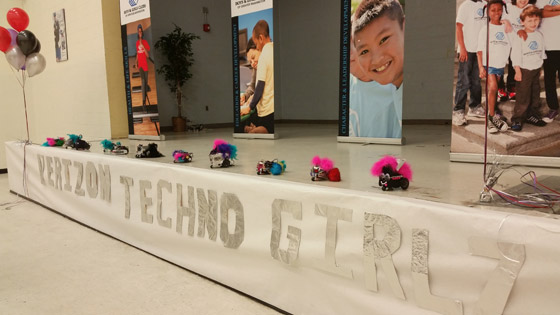Our 2014 STEM adventure into robotics took us back to the Boys & Girls Clubs of Greater Washington. But this time with an all-female information technology Verizon volunteer team and an all- female group of students from the club’s SMART Girls program.
The 2013 robotics program had been a huge success, with our team of four IT volunteers providing 20 co-ed students, ages 9-14, hands-on exposure to a wide array of technical career options including hardware, software and electronics engineering. But as technologists, we always strive to take technology to the next level, so we added open source software and hardware and needed to modify our approach accordingly to teach these challenging new concepts.

In our brainstorming sessions about the robotics program, with ideas and excitement readily flowing among the volunteer team’s members, the idea of a “sisterhood for STEM” was born. Motivated by objectives of the STEM initiative and the low rate of females pursuing careers in science, technology, engineering and math, we seized the opportunity to be testaments of the benefits of pursuing STEM careers and to bring that testimony to the group that needed it most: smart, capable, open-minded females. When we asked our great partners at the Boys & Girls Clubs of Greater Washington for an all-female student team, the BGCGW responded with 11 amazing 10- to 14-year-old girls from the SMART Girls program. SMART (Skills, Mastery and Resistance Training) Girls is a year-round national program of dynamic sessions, group activities, field trips and mentoring opportunities with adult women.
The Verizon volunteer team was already undertaking a challenge by adding advanced technology. And, adding an all-female student team was even more challenging. How would we present this material so that it held the girls’ attention, motivated their interest in technical concepts and increased their confidence to build a robot from scratch? These girls had many different interests and aspirations, 90 percent of which were nontechnical. But they had poise and confidence, were focused and assertive, and had the intellect and self-assurance not just to build robots but to run for president. The girls called themselves Techno GIrlz, and so did we.
The Women of Verizon (as we were called), designed a program for the girls. We compressed the timeline to eight weeks, increased the software programming and added an arts component because the BGCGW also emphasizes the arts. We wanted to make technical careers accessible, conceivable and achievable. In the end, we became sisters. The girls learned software programming using open source software; built the robotic frame using open source hardware engineering concepts; built and modified circuits to power their robots using electronics engineering; learned about mobility trends and GPS technology from Verizon experts; and decorated and “blinged out” their robots using their own individual sense of style.
We celebrated this team and its accomplishments in a closing ceremony on Dec. 5. Several girls shared their experience in the program. They spoke about overcoming doubt and fear of failure, about developing teamwork and trust, and about their pride in seeing what they had accomplished individually and as a team.
We plan to stay in touch with these girls, and we will continue to expose them to new sciences, technologies and challenges.
Their future is bright as long as we reinvest the wisdom and experience that each one of us has to offer. Thank you Verizon and BGCGW for your partnership and commitment to our youth. A special thanks to my IT team – the Women of Verizon – Heather Ferguson, manager of process engineering; Takiyah George, manager of information technology; and Venus Mascarenhas, retired assistant director of information technology.
This article was contributed by Angela Congo, director of systems engineering at Verizon.